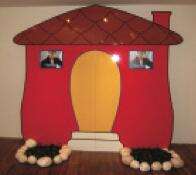Cali: Fallas de Origen
La Central, Bogota
The politics of blood and fear established by Pablo Escobar and the Medellín Cartel with the aim of subjecting the Colombian society to their rule was very different from the one applied in Colombia’s Western Region by the Rodríguez Orejuela family and its Cali Cartel, that resorted to figureheads to penetrate the most recondite corners of the Cali society. And this issue is precisely the central theme of this exhibition, which gathers together four artists under the curatorship of Juan Sebastián Ramírez. Particularly noteworthy in this exhibit is Wilson Díaz’s (Pitalito, 1963) Fallas de origen, the installation awarded First Prize at the 37th National Artists Salon in 1998, which represents the emblematic “red house”, still the logo of the Davivienda Bank, and which contains in its front garden, besides rocks, coca plants that pose a strong criticism of the way in which drug trafficking has made its way even into the most unexpected corners of households: the front garden.

José Horacio Martínez (Buga, 1961), the winner of the 35th National Artists Salon, exhibits a video and a number of draw- ings from his series El guardaespaldas (The Bodyguard), which apparently features variations of the same image, but whose repetition reiterates the category of instruments in the case of the individuals who practice this profession for the benefit of the drug lords. For his part, Leonardo Herrera (Cali, 1976) presents a series of Polaroid photographs with annotations in the manner of a family album, which he entitles El origen de las cosas (The Origin of Things), and which shows a part of the city that has remained paradoxically free from the “aesthetic” influences established by drug traffic.
By means of two prints, Margarita García (Bogotá, 1978) shows how the horse −the symbol of Cali’s Cavalcades − and the little red devil − the icon that represents Cali’s “America” soccer club − have become degraded to the point of becoming slips of paper used to roll basuco (a mixture of drugs similar to crack) cigarettes, in a work bearing the suggestive title of Los carteles de Cali (The Cali Cartels).





